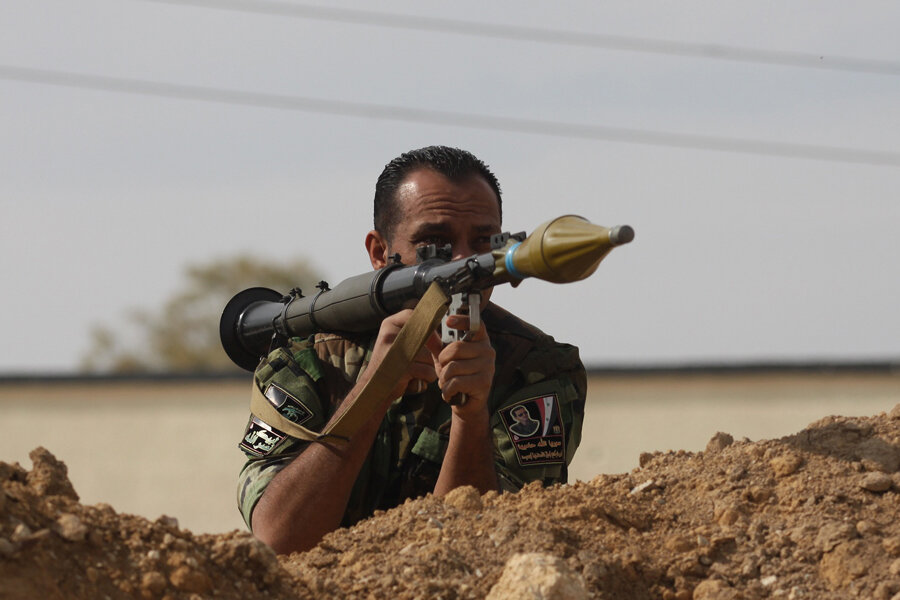Battlefield lessons in Syria strengthen Hezbollah's fighting force
Loading...
| Beirut, Lebanon
Fighters from the Lebanese militant group Hezbollah have helped Bashar al-Assad's regime to stay in power and roll back some of the earlier battlefield gains made by the Syrian armed opposition.
Hezbollah’s involvement in the Syrian conflict, however, has had a spin-off benefit for the Iranian-backed organization: turning a new generation of young recruits into battle-hardened veterans. This experience should make them a more capable combat force in the event of another war against Hezbollah’s arch enemy – Israel.
Amid the grinding brutality of Syria’s war, analysts say Hezbollah combatants have learned valuable lessons in mounting offensive and defensive operations in urban and rural environments. They have learned how to coordinate with other forces, such as the Syrian army and loyalist paramilitaries; how to build supply lines to sustain long periods of fighting; and simply experience the rigors and chaos of combat.
“I think that for Hezbollah the benefits of the experience is going to vastly outweigh the costs in terms of competency,” says Andrew Exum, a former US Army officer in Afghanistan who recently served in as Defense Department advisor on Middle East policy.
Those costs, in military terms at least, include the deaths of veteran commanders and fighters who cut their teeth against Israeli troops in south Lebanon in the 1980s and 1990s. In the past week, Hezbollah reportedly has suffered more casualties from heavy fighting in the Eastern Ghouta region east of Damascus. Lebanese media reported that two of the dead, Ali Mahmoud and Wissam Sharafeddine, were experienced military commanders in their 30s.
The total number of Hezbollah casualties in Syria is estimated to be in the low hundreds. As of Dec 1, the UK-based Syrian Observatory for Human Rights, which collects information from opposition activists across the country, put the number of Hezbollah dead at 232. By contrast, total losses among pro-Assad forces, including army troops and paramilitary loyalists, stood at nearly 51,000, the organization estimates.
On the other hand, for every Hezbollah veteran lost in the war, dozens of new recruits are gaining vital combat experience, experience they wouldn't have gained in the more than six years of relative calm along Lebanon’s southern border with Israel. Hezbollah fighters initially spent an average of one week in Syria. In recent months, this rotation was raised to a month, according to security analysts.
According to sources close to the party, the rate of rotation has increased, a decision apparently aimed at allowing as many Hezbollah fighters as possible to gain battlefield experience.
“It's clear that Hezbollah … has sustained some serious combat losses in Syria and some of those older soldiers are going to be tough to replace,” Mr. Exum says. "But those younger soldiers are getting immense training and experience as well."
Increase in fighting forces
Prior to 2006, when it last fought openly with Israel, Hezbollah’s cadres were numbered at a few thousand, a mix of full-time fighters and reservists. In recent years, however, Hezbollah has significantly expanded its fighting force in anticipation of a future conflict with Israel.
Today, estimates of its total strength vary widely from around 20,000 to 50,000, many of them reservists who have trained at camps in the Bekaa Valley but hold down day jobs. Before the Syria war erupted in 2011, only a fraction of these fighters had any previous combat experience.
According to sources close to Hezbollah, Syrian rebels and Western diplomats, Hezbollah has fought in most of the fronts in Syria, including Damascus, Homs, Aleppo Province in the north and Deraa province in the south. In May, Hezbollah led a successful assault against the rebel-held town of Qusayr, five miles north of the Lebanese border.
More recently, Hezbollah fighters have joined a battle for the mountainous Qalamoun region, a support hub for rebels in Damascus that is adjacent to Lebanon’s eastern border.
In a speech two weeks ago, Sheikh Hassan Nasrallah, Hezbollah’s leader, said that his fighters would remain in Syria to “defend Lebanon, Palestine, the Palestinian cause and Syria which is the backbone of resistance” against Israel.
Conflict enters new phase
For decades, Israel’s occupation of south Lebanon ensured that Hezbollah’s fighters were engaged in near-daily operations. After Israel pulled out in May 2000, the conflict moved into a new phase: Hezbollah switched to rocket and mortar attacks against Israeli army positions in an occupied mountainous pocket along Lebanon’s southeast border.
These attacks every two months or so only involved small numbers of fighters, while others were kept busy with reconnaissance missions along the border and with building Hebollah’s network of underground bunkers, tunnels and rocket-firing positions. These defenses proved vital to Hezbollah’s resistance against invading Israeli troops in the month-long war in 2006.
Since then, the Israel-Lebanon border has witnessed its longest period of calm in more than 40 years.
Still, the benefits accrued to Hezbollah from battling Syrian rebels are significant, since a future conflict with Israeli forces could play out very differently from ongoing operations in Syria in support of Assad’s forces.
Jeffrey White, defense fellow at the Washington Institute for Near East Policy, says that some of Hezbollah's combat experience, but not all, will be applicable to other wars, such as coordination of allied forces and a “hardening of units” to make them more resilient on the battlefield.
For example, in Syria, Hezbollah has the backing of the Syrian military’s artillery guns and its fleet of jets and helicopters. In fighting Israel, however, Hezbollah would likely maintain the defensive posture it adopted in 2006 to protect its long-range rocket batteries from Israeli attack. Instead of benefitting from air support, Hezbollah’s cadres would be on the receiving end of the Israeli air force.
“Syria is a different theater to Israel," Mr. White says.





